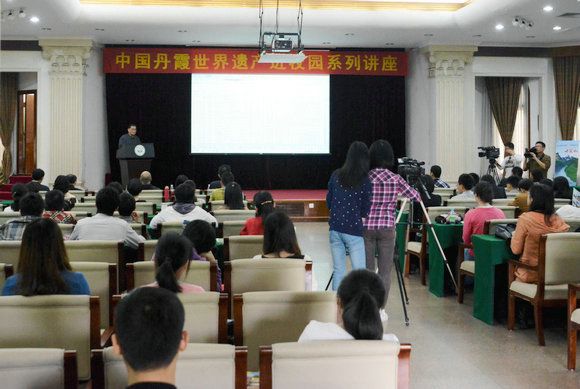Telling the Story between SYSU and Danxia
Source: News Center, School of Geography and Planning
Written by: Gao Fei
Photos by: Guo Zhongfei
Translated by: Chen Zhiyong
On the morning of March 17, “China Danxia: World Heritage in Campus” Serial Popular Science Promotions Activities launched by the Administrative Committee of Danxiashan, Science and Education Bureau of Department of Land and Resources of Guangdong Province, and Sun Yat-sen University, held its first lecture in Swasey Hall on South Campus. Prof. Huang Jin of Geography and Planning School, SYSU, who is praised as “Xu Xiake in our time”; Prof. Peng Hua, Danxia Geomorphology Working Group Chair, Director of World Heritage Expert Committee for China Danxia, and Former Head of Danxia World Heritage Application Expert Group; Prof. Liao Wenbo of School of Life Sciences, talked about Danxia landform for faculty and students of SYSU and the community. Relevant persons in charge from SYSU Geography and Planning School, Science and Education Bureau of Department of Land and Resources of Guangdong Province, and the Administrative Committee of Danxiashan also attended the lecture.

Prof. Huang Jin sharing stories about Danxia with audience
Since 2010 when China Danxia (including Chishui, Guizhou; Taining, Fujian; Langshan, Hunan; Danxiashan, Guangdong; Longhushan, Jiangxi; and Jianglangshan, Zhejiang) succeeded in applying for the status as World Heritage, Danxia has been more widely known, and gained international fame as the quintessence of Chinese landscape. As to its origin, Danxia and SYSU are closely connected. According to Prof. Huang Jin, who is now 86 and a leading expert in Danxia studies, “Danxia landform” was coined by the late Prof. Feng Jinglan, renowned geologist and Academician of Chinese Academy of Sciences, and the late Mr Chen Guoda in the 1920s and 1930s after the name of Danxiashan in Shaoguan, Guangdong; Prof. Wu Shangshi, former Head of Department of Geography was also a contributor. By now, there are 995 known and studied Danxia landforms in China; Prof. Huang Jin has studied 980 of them: he has left his footprints across China.
Later, Prof. Peng Hua, who played a key part in China Danxia’s application for World Heritage, introduced this unique landform from its heritage value, landscape value, and the perspective of protective development. He first explained in detail the concepts of “Danxia” and “red-beds”, and the difficult process of application, expounding on the connections and differences among the six sites of Danxia landform. Prof. Peng Hua said, China Danxia’s success in applying for World Heritage was due to its high aesthetic and scientific value. He also believed that Danxia landform is a combination of formal beauty and classical Chinese beauty, with a harmony of Buddhist and Taoist cultures and various peaks, reflecting the ancient Chinese thinking of harmony between man and nature and a Chinese aesthetic longing.
Prof. Liao Wenbo gave a popular science talk about the flora of Danxia landform from the perspective of biology, taking Danxiashan in Guangdong as an example. He demonstrated the advantage of biodiversity which is suited to Danxiashan and its landscape. He thought it is a perfect combination of ecological value and aesthetic meaning.
According to the organisers, these serial activities were intended to implement relevant requirements in “National Tourism and Leisure Outline (2013-2020)”. They sought to lay the foundation to cultivate all-rounded university students by holding popular science lectures; and to popularise scientific knowledge about Danxia and make it a familiar name among people.
The beauty of red mountains, green water and colourful clouds is unparalleled. And the links between SYSU and Danxia will be renewed by every generation.
